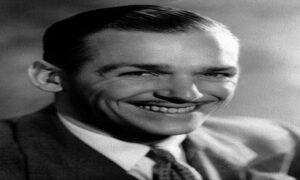Doctor Curmudgeon® Not Just Another Pretty Face!
By Diane Batshaw Eisman, M.D. FAAP Doctor Eisman is in Family Practice in Aventura, Florida with her partner, Dr. Eugene Eisman, an internist/cardiologist
Many decades ago, at the beginning of World War II, there was a famous actor/producer by the name of Douglas Elton Fairbanks, Jr.
He was only thirteen years old when Paramount Pictures offered him a three year contract for one thousand dollars a week.
Fairbanks was handsome, superbly talented and appeared in many of the most acclaimed films of his era.
In 1939, he was instrumental in establishing the Douglas Voluntary Hospitals in Britain, in order to take care of the RAF (Royal Air Force). He even funded them.
It is not as well known that at the beginning of World War II, he was commissioned as a reserve naval officer.
Through his family connections, President Roosevelt sent him to South America under the cloak of studying the effect of American movies on public opinion. But his actual assignment was to investigate how deeply entrenched was Nazism and to present a plan for the United States to implement.
This Hollywood actor then became an assistant gunnery officer, watch officer and assistant communications officer on the USS Ludlow.
He wanted to be more active. British Admiral Lord Louis Mountbatten was a family friend. He was able to have Fairbanks assigned to his own commando staff in the United Kingdom. Mountbatten had established this as an exchange program for officers who became trained in explosives and misdirection. Mountbatten’s Combined Operations Staff assignment allowed Fairbanks to study the effects of bombs and explosives, deceptions and camouflage. This group developed amphibious war plans that could be implemented utilizing a limited force.
It was Winston Churchill who insisted that such a unit of special forces was necessary in order to carry out raids in parts of Europe that were occupied by Germany.
Fairbanks was delighted to be a part of this group.
At one point, he was assigned to a secret amphibious naval base. the HMS Tormentor. Trained there in pilotage and navigation, he soon was placed in command of a flotilla of amphibious raiding craft.
On his return to the United States, he served on the cruiser, USS Wichita,. The Wichita was part of the cruiser covering force protecting the allied arctic convoy that was headed to Murmansk and Archangel. It was code named PQ17.
Indeed! Douglas Fairbank, Jr. was not just some handsome, famous Hollywood Star.
In 1942, he was assistant gunnery officer, flag lieutenant and aide to the task force commander of the battleship USS Washington. He was the officer who was also tasked with keeping detailed reports for naval records.
But what brought his incredible military career to my attention was his idea for a program called the Beach Jumpers.
The Navy Seals have fascinated me. Brave men who achieve remarkable things. There are books, movies and television shows about their courage and skill.
Fairbanks was at Virginia Beach under the command of Admiral H. Kent Hewitt. Hewitt was tasked with the preparation of naval forces for the invasion of North Africa.
After his experience with Mountbatten’s Combined Operations unit, Fairbanks was convinced that such a unit would be integral.to the navy. And so, Fairbanks convinced Admiral Hewitt to allow him to speak with Admiral Ernest King, the Chief of Naval operations. Fairbanks pitched his idea of a military deception unit and King and the “powers that be” in Washington agreed.
King had a secret letter issued seeking one hundred eight officers and three hundred enlisted men for this new Beach Jumpers program.
“The Navy is requesting volunteers for prolonged hazardous, distant duty for a secret project,” said the letter.
And so, the birth of the Navy Seals began with the exhaustive training of the Beach Jumpers. They misguided the enemy by deceptive practices, leading them to believe an amphibious landing was occurring in one location, when actually it was elsewhere.
From the Navy Beach Jumpers Association:
“The basic mission of Beach Jumper Unit-1 was to assist and support the operating forces in the conduct of tactical Cover and Deception in Naval Warfare. Small boat handling, seamanship ordnance, gunnery, demolitions, pyrotechnics, and meteorology were among the courses taught. Beach Jumpers were also cross-trained to handle all crew positions.”
They saw their first action in Operation Husky, the invasion of Sicily.
Douglas Fairbanks was awarded many honors.
From Naval History and Heritage Command:
“For exceptionally meritorious services, Commander Fairbanks was awarded the Silver Star Medal and the Legion of Merit.
“In addition to the Silver Star Medal and the Legion of Merit, Commander Fairbanks had the American Defense Service Medal, Fleet Clasp, with bronze “A,” (USS MISSISSIPPI); the American Area Campaign Medal; the European-African-Middle Eastern Area Campaign Medal with one bronze star (USS WICHITA); the World War II Victory Medal; and the Expert Pistol Shot Medal. He also had the Decoration and Diploma of Officer of the National Order of the Southern Cross, conferred by the Brazilian Government; the Legion of Honor (Chevalier), and the Croix de Guerre with Palm, by the Government of France; and the Distinguished Service Cross, awarded by the Government of Great Britain.”
A real life naval officer, not just a pretty face.
Dr. Curmudgeon suggests “Bitter Medicine”, Dr. Eugene Eisman’s story of his experiences–from the humorous to the intense—as a young army doctor serving in the Vietnam War.
Bitter Medicine by Eugene H. Eisman, M.D. –on Amazon
Doctor Curmudgeon® is Diane Batshaw Eisman, M.D., a physician-satirist. This column originally appeared on SERMO, the leading global social network for doctors.
SERMO www.sermo.com
Click Here to Order Boxing Interviews Of A Lifetime By “Bad” Brad Berkwitt


